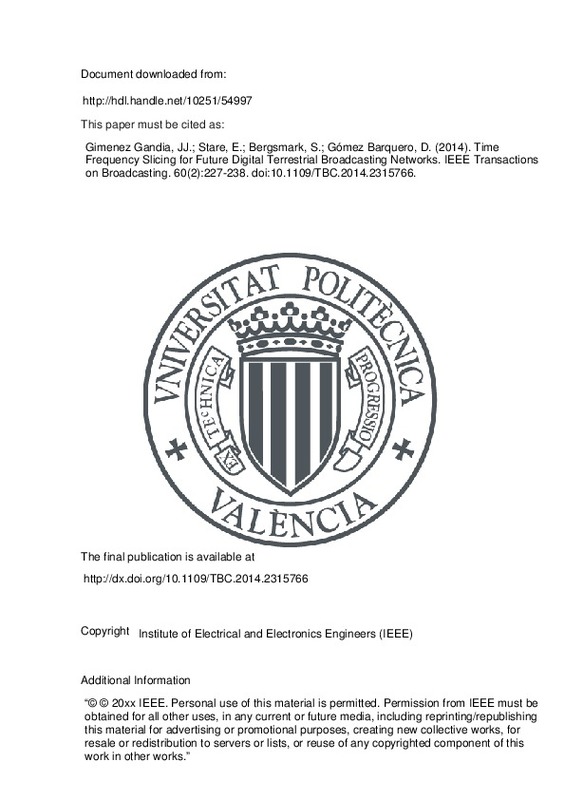JavaScript is disabled for your browser. Some features of this site may not work without it.
Buscar en RiuNet
Listar
Mi cuenta
Estadísticas
Ayuda RiuNet
Admin. UPV
Time Frequency Slicing for Future Digital Terrestrial Broadcasting Networks
Mostrar el registro sencillo del ítem
Ficheros en el ítem
| dc.contributor.author | Giménez Gandia, Jordi Joan
|
es_ES |
| dc.contributor.author | Stare, Erik
|
es_ES |
| dc.contributor.author | Bergsmark, Staffan
|
es_ES |
| dc.contributor.author | Gómez Barquero, David
|
es_ES |
| dc.date.accessioned | 2015-09-23T07:10:39Z | |
| dc.date.available | 2015-09-23T07:10:39Z | |
| dc.date.issued | 2014-06 | |
| dc.identifier.issn | 0018-9316 | |
| dc.identifier.uri | http://hdl.handle.net/10251/54997 | |
| dc.description | “© © 20xx IEEE. Personal use of this material is permitted. Permission from IEEE must be obtained for all other uses, in any current or future media, including reprinting/republishing this material for advertising or promotional purposes, creating new collective works, for resale or redistribution to servers or lists, or reuse of any copyrighted component of this work in other works.” | |
| dc.description.abstract | Time Frequency Slicing (TFS) is a novel transmission technique for the future of terrestrial broadcasting. TFS breaks with the traditional transmission of TV services over single RF channels.With TFS, services are distributed across several channels by frequency hopping and time-slicing. The bundling of several RF channels into a TFS multiplex provides important advantages. A capacity gain is obtained due to a more efficient statistical multiplexing of video content since more services can be encoded in parallel. Improved frequency diversity also provides a coverage gain since signal imbalances between RF channels can be smoothed. Enhanced robustness against static and time varying interferences can also be achieved. TFS was described, although not implemented, for DVB-T2 and was fully adopted in DVB-NGH. At present, it is proposed for a future evolution of DVB-T2 and will also be considered in the ongoing ATSC 3.0 standard. This paper investigates the potential advantages of TFS by means of field measurements as well as simulations and discusses practical implementation aspects and requirements regarding transmission and reception. Results demonstrate the interesting advantages of TFS to improve both coverage and spectral efficiency, which addresses the future necessity of a more efficient DTT spectrum usage. | es_ES |
| dc.language | Inglés | es_ES |
| dc.publisher | Institute of Electrical and Electronics Engineers (IEEE) | es_ES |
| dc.relation.ispartof | IEEE Transactions on Broadcasting | es_ES |
| dc.rights | Reserva de todos los derechos | es_ES |
| dc.subject | Coverage gain | es_ES |
| dc.subject | Frequency diversity | es_ES |
| dc.subject | Field measurements | es_ES |
| dc.subject | Statistical multiplexing | es_ES |
| dc.subject | Terrestrial broadcasting | es_ES |
| dc.title | Time Frequency Slicing for Future Digital Terrestrial Broadcasting Networks | es_ES |
| dc.type | Artículo | es_ES |
| dc.identifier.doi | 10.1109/TBC.2014.2315766 | |
| dc.rights.accessRights | Abierto | es_ES |
| dc.contributor.affiliation | Universitat Politècnica de València. Instituto Universitario de Telecomunicación y Aplicaciones Multimedia - Institut Universitari de Telecomunicacions i Aplicacions Multimèdia | es_ES |
| dc.description.bibliographicCitation | Gimenez Gandia, JJ.; Stare, E.; Bergsmark, S.; Gómez Barquero, D. (2014). Time Frequency Slicing for Future Digital Terrestrial Broadcasting Networks. IEEE Transactions on Broadcasting. 60(2):227-238. doi:10.1109/TBC.2014.2315766 | es_ES |
| dc.description.accrualMethod | S | es_ES |
| dc.relation.publisherversion | http://dx.doi.org/10.1109/TBC.2014.2315766 | es_ES |
| dc.description.upvformatpinicio | 227 | es_ES |
| dc.description.upvformatpfin | 238 | es_ES |
| dc.type.version | info:eu-repo/semantics/publishedVersion | es_ES |
| dc.description.volume | 60 | es_ES |
| dc.description.issue | 2 | es_ES |
| dc.relation.senia | 269327 | es_ES |







![[Cerrado]](/themes/UPV/images/candado.png)

